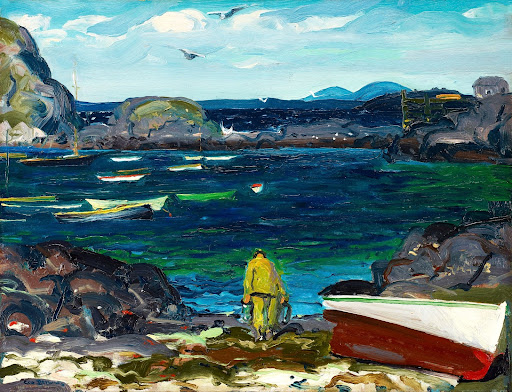Immerse yourself in the history of Downeast Maine, a captivating region known for its rugged coastline, scenic landscapes, and the unmistakable Downeast Maine accent. Whether you’re examining a Downeast Maine map or walking the coastal trails, this region is steeped in rich history and robust cultural heritage that dates back to the early native Americans. Let’s dive into the narrative of Maine’s working coast.
A Brief Look into Downeast Maine’s History
Following the last ice age, the region of Downeast Maine was inhabited by the Red Paint People, who hunted game, built encampments, and navigated the seas in search of swordfish and walrus. Their presence was shared with the Wabanaki Confederacy, whose ancestral homelands included the coast of DownEast Acadia, visiting spots like today’s Mount Desert Island during warmer months.
European explorers started recognizing the region’s potential from the mid-1500s, with settlements established in places like Calais, St. Saveur, Pentagot (Castine), and Machias. However, overlapping claims to the strategic port town of Castine escalated into the first significant conflict between Maine’s French and British settlers.
Downeast Maine also holds its place in the American Revolution, with the taking of the British sloop Margaretta in Machias in 1775 being the first naval battle of this significant period. Further, even after the War of 1812 concluded, Eastport remained under British control for four more years, marking it as the last American territory returned to the U.S.
Downeast Maine’s industrious past also ties into America’s economic history. Herring and anchovies built the fortunes of Eastport and Lubec. Granite mined from deep quarries in Stonington helped shape a growing nation. Furthermore, the wooded town of Princeton, near Grand Lake Stream, once housed the world’s largest leather tannery.
Unveiling the Rich History of Downeast Maine
Several historical landmarks in the region narrate the rich history of Downeast Maine. The Burnham Tavern Museum in Machias is where local patriots planned a defense that led to the first naval battle of the American Revolution.
The Castine Historical Society provides a window into the 400-year history of one of New England’s oldest and best-preserved seaside villages. Enjoy a walk along the Narraguagus River through the Cherryfield Historic District Riverwalk, known for its unique 19th-century architecture in rural Maine.
For military history enthusiasts, Fort Knox at the foot of the Penobscot Narrows Bridge & Observatory is a well-preserved fort on the New England seacoast, regularly hosting guided tours and reenactments.
The Wilson Museum in Castine allows you to explore diverse collections focused on the history and cultures of the Penobscot Bay region, while the Woodlawn Museum, Gardens, and Park in Ellsworth, once home to the Black family, is now a public museum with formal gardens, park, and walking trails.
Deciphering the Term “Downeast”
The term “Down East” or “Downeast” usually refers to the eastern coastal region of Maine covering Washington County and Hancock County, beginning in Ellsworth and stretching east to the Maritime Provinces. The city of Ellsworth is often called the “Gateway to the Downeast and Acadia Region of Maine,” encompassing Bar Harbor, Mount Desert Island, and Acadia National Park.
The phrase originated from the late 1700s and throughout the 1800s when sailors used schooners to transport goods along the New England coast. Moving in a northeasterly direction, especially during warmer months, they found themselves moving “downwind” or in the direction the wind was blowing. This led to the terms “down” and “east” being combined to form an expression describing a common traveling direction.
The term has further evolved to also signify a geographical area, initially referring to New England in general. The Downeast accent is unique and easily recognized even by long-time Mainers. Most notable is the dropping of “r’s” in pronunciations, turning Bar Harbor into “Bah Ha-bah” or Car into “Cah.”
Unearthing Facts and Exploring Regions of Downeast Maine
Downeast Maine boasts several unique facts, from Eastport being the most eastern city in the U.S., receiving the first morning sun rays, to Maine being the largest producer of wild blueberries in the world. Acadia National Park is the 6th most visited national park in the U.S., and the coastline harbors so many deep harbors that all the navies in the world could anchor in them.
Exploring Downeast Maine’s regions is an adventure unto itself. These areas include but are not limited to the following towns: Westerly Frontier (Brooklin, Sedgwick, and Deer Isle), Middle Frontier (Sullivan, Birch Harbor, Hancock, Harrington, Cherryfield, Milbridge, and Jonesport), Easterly Frontier (Machias, Cutler, Eastport, and Lubec), and the Northern Frontier (Calais, and Grand Lake Stream).
Whether you’re a history buff, nature lover, or just a curious traveler, Downeast Maine offers a unique exploration opportunity. From its rich history to natural beauty and industrious past, the region beckons with its unique charm. Plan your visit and discover the untold stories of Maine’s working coast.
Stay With Us While You Explore Downeast Maine
As you embark on your journey to explore the historic and captivating Downeast Maine, consider making Salt Air Property Management your home away from home. Our properties, centrally located amidst the picturesque towns of this region, offer the perfect gateway to the many attractions of Downeast Maine.
At Salt Air Property Management, we’re more than just your hosts – we’re your partners in discovering the magic that is Downeast Maine. Let us make your stay unforgettable. Book your stay today!

